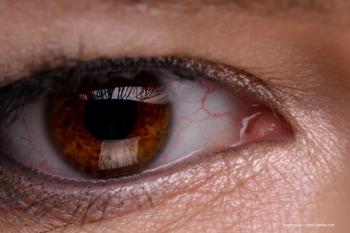
Tocilizumab effective for managing posterior segment inflammation
Improvement in visual acuity, central retinal thickness, vitreous haze reported at 6 months
The STOP-Uveitis Study has shown that intravenous infusions of the humanized monoclonal antibody tocilizumab are effective as a novel therapeutic management approach for non-infectious uveitis.
Reviewed by Muhammad Hassan, MD; Mohammad Ali Sadiq, MD; Yasir J. Sepah, MBBS; and Quan Dong Nguyen, MD, MSc
Repeated intravenous infusions of
Further analysis of data from the STOP-Uveitis Study also indicates that tocilizumab is effective in improving posterior segment inflammation in eyes with non-infectious intermediate, posterior, and panuveitis, according to Muhammad Hassan, MD, chief clinical research fellow, Byers Eye Institute, Stanford University, Stanford, CA.
He highlighted 6-month outcomes from the STOP-Uveitis Study, a phase I/II trial conducted at five clinical sites in the United States. In this randomized, open-label safety, tolerability, and efficacy study, 37 patients were assigned 1:1 to receive intravitreal infusions of 4 mg/kg or 8 mg/kg of tocilizumab, an antiinterleukin-6 antibody. Patients received monthly infusions from baseline through month 5, then as needed starting at month 6.
Tocilizumab is approved for the treatment of rheumatoid arthritis, giant cell arteritis, systemic juvenile idiopathic arthritis, polyarticular juvenile idiopathic arthritis, and cytokine release syndrome. In addition, tocilizumab has demonstrated safety and efficacy in several small, single-center studies of cases with non-infectious uveitis and uveitic macular edema refractory to other immunosuppressive therapies. Efficacy outcomes were mean change in best-corrected visual acuity (BCVA), central retinal thickness (CRT), and vitreous haze.
Six-month data from the combined groups showed a statistically significant (p < 0.01) mean improvement in BCVA of 8.22 ETDRS letters, from a mean of 37.78 letters at baseline to 46.0 at the 6-month endpoint. Both study groups demonstrated a statistically significant change from baseline of 10.94 letters for the low-dose group and 5.5 letters for the high-dose group.
The mean change in CRT for the combined groups was also statistically significant (p < 0.01), 83.89 μm at 6 months (358.25 μm at baseline to 274.37 μm at the endpoint). The changes for the 4 mg/kg and 8 mg/kg groups were 131.5 μm and 38.91 μm, respectively.
The haze analysis scores at month 6 showed a decrease of 1 step or more in 77.4% (n = 24) of patients in the combined treatment groups and a decrease of 2-steps or more in 32.2% (n = 10). Out of the 37 patients, only 23 patients had the potential for 2-step improvement, and among these 43% (10 patients) demonstrated a 2-step improvement, he said. There was no change in 7 patients (22.6%), and haze worsened in 1 patient.
Primary outcomes
The primary outcomes of the STOP-Uveitis study were published in the American Journal of Ophthalmology in late 2017. However, because 14 of the patients in the study did not have the potential for 2-step improvement in vitreous haze, the investigators wanted to analyze the effect of tocilizumab on posterior segment inflammatory outcomes using a semi-quantitative fluorescein angiography (FA) scoring system.
This system was developed by the Angiography Scoring for Uveitis Working Group in 2010 to assist in the follow up of progression and monitoring treatment response in uveitic patients. A maximum score has been derived for each of 9 angiographic signs with a possible total score of 40.
The components are: optic disc hyper fluorescence, macular edema, retinal vascular staining/leakage, capillary leakage, retinal capillary nonperfusion, neovascularization of the optic disc, neovascularization elsewhere, pinpoint leaks, and retinal staining/pooling.
This system was used to analyze FA images and calculate inflammatory scores at baseline and month 6 visits in the STOP-Uveitis Study; two trained graders from the Ocular Imaging Research and Reading Center (Sunnyvale, CA) analyzed all images.
Thirty eyes were eligible for analysis and 7 were excluded. Both dosing groups showed a statistically significant reduction in FA inflammatory scores from baseline to month 6 (p < 0.05). The difference in mean reduction between the 2 dose groups was not statistically significant.
Overall, the mean score at baseline was 5.37 compared to 2.71 at month 6 (p < 0.002). For group 1 (n = 15) receiving the 4 mg/kg dose, the score improved from 6.33 to 3.22 (p < 0.026); for the 8 mg/kg group (n = 15), the score improved from 4.35 to 2.18 (p < 0.033).
The difference in mean reduction between the two groups was not statistically significant. The study suggested that repeated intravenous infusions of tocilizumab are well tolerated and effective in improving visual acuity, reducing haze and retinal edema and improving inflammation, but further monitoring of patients is needed to assess the long-term benefits of tocilizumab for the treatment of noninfectious uveitis and uveitic macular edema.
Based on the limited data from the study, the higher dose does not seem to provide any additional benefit over the lower dose and that further studies with IL-6 inhibition are needed to elucidate the role of IL-6 inhibitors in the armamentarium for uveitis therapy.
Disclosures:
Muhammad Hassan, MD
P: 402/953-6773
E: hassanm@stanford.edu
This article was adapted from Dr. Hassan’s presentation during the 2018 meeting of the American Academy of Ophthalmology. Dr. Hassan did not report any relevant financial disclosures.
Mohammad Ali Sadiq, MDDr. Sadiq is a clinical research fellow in the Department of Ophthalmology at Stanford University. Dr. Sadiq did not report any relevant financial disclosures.
Yasir J. Sepah, MBBSDr. Sepah is a senior research scientist at Stanford University. He did not report any relevant financial disclosures.
Quan Dong Nguyen, MD, Msc
E: ndquan@stanford.edu
Dr. Nguyen is a professor at the Byers Eye Institute, Stanford University. Dr. Nguyen did not report any relevant financial disclosures.
Newsletter
Keep your retina practice on the forefront—subscribe for expert analysis and emerging trends in retinal disease management.












































